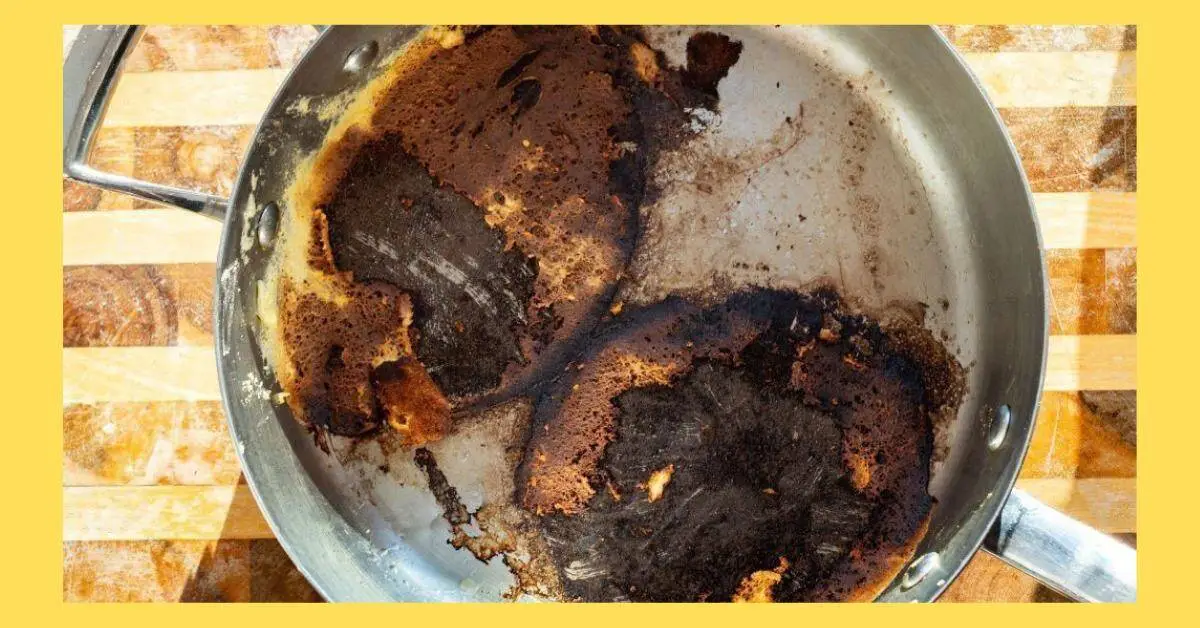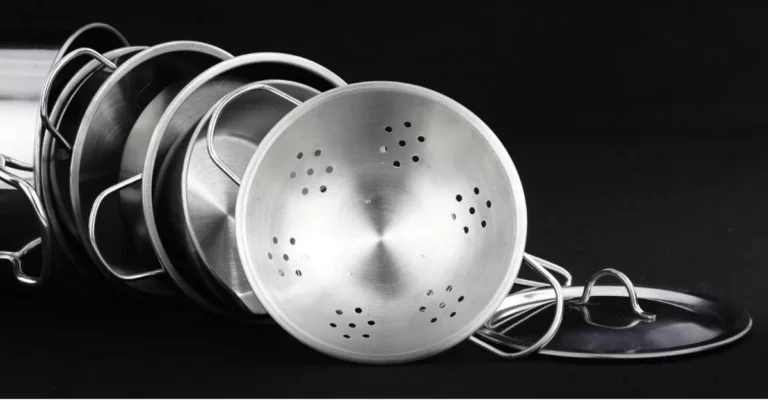In this article I’ll be talking about cleaning hard anodized aluminum cookware, and what the best approaches are in certain situations.
If you have aluminum cookware, especially the hard anodized ones, lying around in your kitchen for a long time and it’s been a while since you used them. Or maybe you have been using them too regularly without cleaning them. Or perhaps you just want to get rid of stains and discoloration on the sides and the back of your pans.
Then this is it. I have gone in depth into what you should do in any scenario and what you should avoid. Don’t worry, it’s not really all that tough. Just keep a few basic points in mind and you’re done.
Let’s get into it.
Table of Contents
Just your Average Everyday Cleaning Routine

Supplies Required
- Water
- Sponge, brush or rag
- Dish soap
- Towel for drying
Procedure
Now you may be using your aluminum cookware every day and washing them subsequently. For which you do not need to use any elaborate methods to get them cleaned.
Just normal dish soap and a sponge will do. If you want to go the extra mile, use lukewarm water with dishwashing liquid, and a brush with soft bristles to keep those utensils shining.
Wipe them up with a towel or a microfiber cloth. Then leave them out to dry.
Cleaning your hard anodized aluminum cookware regularly just after you use them would dispel the need to look into further methods of rigorous cleaning for more stubborn stains.
However, it is understandable that in this busy world we are generally left with no time or energy to wash them every day. And especially not right after cooking.
I assume the average reader of this website does not employ a housemaid to take care of these things for them. So even if I always recommend handwashing aluminum utensils as part of a regular routine, it is sometimes not very plausible.
In such cases, we move on to the next scenarios.
Cleaning Stubborn Stains and Residue

Method 1
This method is just a fancier version of the previous method that talked about everyday cleaning.
Supplies required
- Hot water
- Liquid dish soap
- Soft sponge or brush with soft bristles
- Towel for drying
- First you fill your kitchen sink with hot water. Then add a few drops of dish soap to it.
- Now place your dirty anodized aluminum pots and pans and let them rest for about 15 to 20 minutes.
This will disintegrate the stubborn bits of food stuck to the surface of your pans and aid in easier cleaning overall. - After the waiting period is over, take a soft spring or brush and gently scrub the interior to remove the softened bits of scrap.
Take your time in this step, as no one would want to keep cleaning repeatedly. Might as well get rid of all the burnt food in one go. - Take care so as to not to scratch the pans. Using abrasive steel wool or tough bristled brushes can damage the build.
- Once you’re done, rinse them all off with running water and pat dry with a clean towel.
- You can now proceed to let them air dry.
Method 2
This method is for those who are looking to get rid of burnt particles stuck on the surface and are unyielding to the normal washing methods mentioned above.
Supplies required
- Vinegar
- Water (both room temperature and hot)
- Soft sponge or brush with soft bristles
- Towel for drying
- Firstly, fill the sink up with water and vinegar in a 3:1 ratio.
- Add your hard anodized kitchenware to the sink and make sure they’re well engulfed in the vinegar mixture.
- Let the aluminum cookware rest for 15-20 minutes, as they soak up the vinegar. The stubborn particles of residue bonded with the pan will slowly dislodge.
- After enough time has passed, empty the sink and fill it again with hot water. Add some detergent and submerge your cookware in it.
- Wait again for 15 minutes before you proceed to clean the pots with a sponge or brush.
- Towel dry after washing.
- Leave them out for a while to make sure all the water is gone before storing them.
Method 3
This procedure can be adopted in case you do not have vinegar at home. It gives the same, and sometimes even better results so do not fret.
Supplies required
- Baking soda and water for making a paste
- Rubber gloves or a soft cloth
- Some patience
- Mix your baking soda powder with a bit of water to make a mushy paste.
- Use rubber gloves to coat the pans and pots with this paste if you are using your hands. Ensure you do not get any baking soda paste onto the interior of the pans.
- Or you could use a soft cloth to cover the cookware with the paste. Although this runs the risk of having the paste stick on the rag and leading to wastage.
- Leave the cookware as is, to soak them up completely in the baking soda. An hour of resting will do.
- Now wash them under running water. You may use a brush if you want, but it’s optional as the effects of the baking soda paste is a bit on the abrasive side anyway.
- Dry them with a towel when done with rinsing.
- Repeat the steps if needed.
This method usually takes some time as the manual coating of utensils may prove to be quite tiring. Apart from the time needed for them to rest, the repeated procedure and rinsing and coating again may also be quite time-consuming.
So, keep this in mind before opting for this method.
Method 4
Yet another not-so-unconventional method for cleaning hard anodized aluminum pots and pans. This one works just as well as the rest.
- Rinse your pans and pots wet. Although it is recommended you do this with a single pan first before moving on to others.
- Wear your rubber gloves and sprinkle some Bar Keeper’s Friend powder cleaner over the surface of the utensil. Do not use bare hands to perform this step as BKF is an oxalic acid that may react with your skin.
- Take a soft cloth and rub over the powder and the areas with stubborn residue on it. Rub gently but not for too long.
- After about a minute of spreading the product over the pan, rinse it thoroughly. If you let the powder stay on the surface for too long it may cause discoloration and scratches on the metallic surfaces.
- Repeat the process if required.
- Now dry the rinsed cookware with a towel.
Other Alternate Methods
Method 5
Supplies required
- Lemon juice
- Salt
- Soft sponge or cloth
- Towel for drying
- Mix salt and lemon juice in equal parts. It also works if you mix lemon juice with baking soda.
- Apply this mixture to the parts of your cookware that are stained.
- Let them rest for about half an hour.
- Gently rub over the affected parts with a washcloth or sponge.
- Rinse under running water.
- Dry them with a towel before storing them.
Method 6
Supplies required
- Cream of tartar
- Hot water
- Soft sponge or washcloth
- Towel for drying
- Mix cream of tartar and water into a paste.
- Smear the paste onto the stained parts of the pots and let them rest for 15 minutes.
- Rub gently over the surface where the paste is applied, using a sponge or washcloth.
- Thoroughly rinse under running water.
- Dab dry with a towel.
Note: It’s also important to remember to air dry after wiping the pans after washing otherwise remaining moisture may invite rusting and water spots.
What NOT to do while cleaning hard anodized cookware
- Do not clean the aluminum cookware just as soon as you’re done cooking. You must let them cool down completely before washing them.
- This will keep any sudden changes in temperature at bay and prevent abnormal contractions in the build which may lead to warping.
- Do not use rough scrubbers or scrapers to remove stubborn particles of food. This may have long term damaging effects on the exterior and the interior of the utensils.
Using steel wool and similar scouring tools will damage the aluminum surface and expose the underlying metal. This will negatively impact the efficiency of the cookware and you may have to end up buying a new set sooner rather than later. - If you don’t have a usable sponge or brush, you can always use a soft rag to wipe off your pans.
- Whenever possible, stay away from the dishwasher. If you have the time, handwashing is the way to go.
- Always use gloves if you use Bar Keeper’s Friend to clean your anodized cookware. Make sure to not inhale them while using and definitely do not keep them applied for longer than a minute.
It is also not recommended to apply it on cast iron or granite cookware. - Alkaline cleaning methods like baking soda paste must not be used on the interior of the pans as they can cause damage to the coatings and such.
- Do not use cleaning products that aren’t meant for kitchenware. For instance, bleach, floor cleaners, surface polish or even oven cleaning sprays that include chemicals like ammonia and other hydrocarbons that cause more harm than good.
- Save scouring pads and slightly abrasive cleaning tools for the exterior of pans, if you think they need more than a nudge to get cleaned. But usually, the aforementioned methods work without the need for scraping tools.
But in some cases, it may happen that anodized aluminum utensils aren’t the best fit for your kitchen needs. If so, its worthwhile looking into stainless steel for your culinary needs. One of the most popular and long-lasting materials for cookware – it can be your go-to build when it comes to cookware.
To further help you choose between anodized aluminum and stainless steel for your kitchen, here’s a post that highlights the difference between them and guides you towards the right choice depending on your individual needs.
Remember, choosing the right kitchenware is a personal choice, and understanding the differences between these materials is key. Happy cooking!
FAQ
How often should hard anodized aluminum be cleaned?
Hard anodized cookware should always be cleaned right after use. That way, its efficacy and durability is prolonged and there’s a reduced risk of damage.
If you plan on using cold water to clean them, make sure you cool down the cookware first.
How do I remove water spots from them?
Water spots are formed when moisture is retained after washing the cookware, which causes mineral deposits to be left over the surface. This appears as a stain and can be prevented by letting the aluminum cookware air dry for enough time after washing, before we proceed to store them.
In case they are already formed, use a mixture of salt and lemon juice to apply on the affected areas. Let it rest for half an hour, before wiping it down with a washcloth or sponge. Then rinse with warm water.
How do I clean burnt residue from anodized aluminum?
Any of the aforementioned methods should work. But do remember to soak them in hot water and dish soap to let the residue soften before you proceed to scrub them off with a soft-bristled brush or sponge.
Can metal utensils be used with hard anodized aluminum?
No. Using metal with aluminum surfaces with scratch and damage the build which will expose the metal underneath, if done over an extended period of time.
This will react negatively with heat and other foods during cooking and lose its strength and efficiency over time.
How to prevent food from sticking to the surface of aluminum pots?
Before purchasing look out for pans with a nonstick interior. These won’t allow food to get stuck on the cooking surface and usually require little to no amount of healthy oil to prevent sticking.
However, if you already possess cookware without nonstick coating, then a few points should be kept in mind.
- Ensure not to heat the pot or pan for too long before cooking otherwise the high temperature will burn food easily before they are evenly cooked.
- Ingredients used for cooking shouldn’t be taken right out of the fridge or heated right before putting them in the pan. Make sure they are always at room temperature.
- Always use a good amount of healthy oil, or cooking spray before frying your food. The drier the surface is, the more likely it is to stick.
- Always keep in mind the depth of the pot or pan and add ingredients accordingly. If you pour in more items than the pan can take, the bottoms will stick faster and the top ones will remain undercooked.




